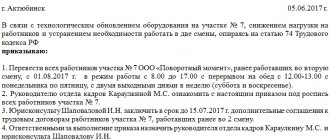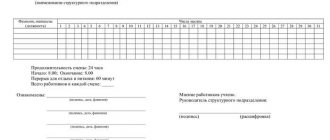Working time according to the Labor Code is a certain time period. During the specified period, each of the workers must carry out the instructions assigned to him, according to his job description. A more detailed explanation of this term can be found in Art. 91 Labor Code of the Russian Federation.
Please note: according to the letter of the law, working hours during a calendar week are 40 hours. The permissible rate for a different period of time (month, year) is calculated based on the weekly equivalent.
It is management's responsibility to maintain a record of the actual hours worked by each employee.
Additional clarifications
Working time is considered to be the time that an employee actually worked during the day. This also includes periods of forced downtime and breaks paid by the company during the working day. This time period may exceed the accepted norm or, conversely, be less than it.
You can calculate the duration of one shift by first defining the weekly norm for each employee.
The Labor Code of the Russian Federation (Section IV, Chapters 15 and 16) clearly regulates the norms of daily and weekly working hours. The Constitution of the country (Article 37, paragraph 5) establishes the right to rest for each worker.
Following Art. 91 of the Labor Code of the Russian Federation, both parties to the labor agreement have the right to designate acceptable limits for the working day. The accepted routine (lunch period, beginning and end of the shift) may also be subject to discussion. The norm established by law, equal to 40 hours per week, is considered the basic one for the vast majority of workers. The following facts do not play a big role:
- Length of the working week (5 or 6 days).
- Organizational and legal form of the company (IP, LLC, etc.).
- Types of work performed.
The law controls compliance with time limits in the labor process, which means:
- Protects every working citizen from overwork and provides him with time to rest.
- Allows any enterprise to receive the required amount of work completed on a daily basis.
- Gives the worker the opportunity to grow as a person, develop culturally and spiritually, and improve his qualifications and skills.
Sometimes a worker’s work is downtime due to circumstances beyond his control. This period of time is also considered working.
How many hours is the pre-holiday day reduced by?
In part 1 stat. 95 it is determined that the working day on pre-holiday days is reduced by 1 hour. This standard applies to all employers and employees. Even if a person performs his duties not all day, but part-time (0.5, 0.25 or 0.75), he is entitled to a reduction in the number of hours of employment on the eve of the holidays. For example, a specialist is registered at 0.5 rates as an external part-time worker. In 2021, February 23 is a public holiday, and February 22 is a shortened day. A part-time worker works 5 hours twice a week in compliance with statutory standards. 284 TK. On the report card for February 22, 2017, the personnel officer will enter not 5 hours for such an employee, but 4.
If, according to the terms of employment, the employee will perform duties, for example, an hour a day, “0” should be entered in the column with the number of working hours on a shortened pre-holiday day. This will not constitute a violation and will confirm that the employer has reduced working hours on the pre-holiday day in accordance with the requirements of labor legislation. Additionally, you will need to complete a number of personnel documents. We figured out how much shorter the pre-holiday working day is , and then we’ll find out in what situations this rule does not apply.
Peculiarities
The Labor Code of the Russian Federation (Article 109) indicates that people working in cold areas or outdoors in winter are provided with additional breaks. They include time not only for eating, but also for heating. Payment for the specified rest time is calculated as for the working period. The decision to provide these breaks is made by the executive branch based on the conditions (wind strength, temperature) under which workers will have to work. The duration is set directly by the employer after agreement with the trade union committee.
Some categories of workers, due to the specifics of their activities, require breaks to perform certain physical training. For example, a driver should warm up for about 20 minutes 1-2 hours after starting his shift. After 2 hours after eating, light exercises will also be required. Workers in other areas of activity may agree on the availability of additional breaks for warm-up with their immediate management.
If the company employs employees who have young children (under 1.5 years), they are entitled to a reduction in working hours due to the presence of additional breaks for feeding. This is evidenced by Art. 258 Labor Code of the Russian Federation. Each break is at least 30 minutes long. Feeding frequency: every 2-3 hours. Payment for these breaks is carried out in the usual way.
Often, the concept of “working time” includes all manipulations associated with the employee’s work activity. These include:
- Preparation/cleaning up the work site.
- Receiving assignments from management.
- Preparing tools, setting up equipment, etc.
- Viewing company correspondence and technical papers.
- Submission of completed tasks, reports, produced materials, etc.
Meanwhile, time spent on:
- The way to work.
- Changing into a change of clothes/company uniform.
- Washing and other water procedures performed before/after work.
- Lunch break.
If an organization is characterized by stable production without interruptions, it must have rules regarding the acceptance and transfer of shifts by employees at the end of the working day. The duration of this process directly depends on the complexity of the equipment and the specifics of the enterprise.
Please note: these standards, in accordance with Art. 58 and 59 of the Labor Code of the Russian Federation are applicable to all employees, regardless of the type of contract concluded (fixed-term, unlimited).
In what cases does the law provide for a working day of less than 8 hours?
Art. Art. 92, 93 of the Labor Code of the Russian Federation provide for cases when an employee’s working time may be less than 8 hours.
First of all, this is when an employee may be required by law to have reduced working hours. Moreover, sometimes in this case the workers’ salary remains full, despite the reduced working hours (disabled people, “harmful workers”), and sometimes the salary is reduced in proportion to the time worked (minors).
Also, at his request, an employee can be assigned part-time working hours, and sometimes such a wish of the employee is mandatory for the employer (for example, in relation to pregnant women). The only possibility of establishing part-time work at the initiative of the employer is by virtue of Article 74 of the Labor Code of the Russian Federation in the event of the threat of mass layoffs. Salary for part-time work is always set in proportion to the time worked.
Time tracking
The employer is required to maintain it separately for each employee. The corresponding timesheet is used as the main document. It should indicate not only daytime, but also evening/night shifts (if provided by the enterprise). The actual hours of work on holidays and weekends, as well as overtime work, downtime, etc., are subject to recording.
If both parties approve the employment agreement, a reduction in the working week is possible. This measure is used as a one-time measure for some time or without specifying specific dates. It is mandatory for some categories of workers. These include:
- Pregnant women.
- One of the parents (guardian, guardian) with a child under 14 years of age.
- Parents of a disabled child under 18 years of age.
- Persons caring for unhealthy relatives (there must be an appropriate medical certificate).
The listed persons are entitled to a shortened working week for the period of time necessary according to the circumstances. Payroll according to this schedule is carried out based on actual output by hour or volume.
It is important to understand that the above circumstances are not grounds for reducing the duration of leave, adjusting length of service or other changes.
What does it mean to reduce working hours on a holiday?
The shortened pre-holiday day immediately precedes the onset of a public holiday. According to this privilege under stat. 95 the duration of work on the eve of an official holiday is reduced, but the salary does not become less. The benefit applies to all categories of specialists, namely:
- Employees arranged for a 5-day week.
- Workers employed 6 days a week.
- Specialists employed on a part-time or reduced-time basis.
- Employees included in the staff as part-time workers - internal or external.
It is impossible to reduce work time in organizations that conduct continuous operations for justified reasons. Employees of such institutions are not entitled to a shortened pre-holiday day, but overtime is compensated in one of the possible ways at the individual’s choice. In accordance with Part 3 of Art. 95, additional time off may be used or monetary compensation is paid, the amount of which is calculated according to the rules for calculating overtime payments. That is, at a minimum of double or one and a half times, depending on what day the employee works (stat. 152, 153 of the Labor Code).
Ways to control working time
The way staff time is monitored, recorded and assessed has evolved over time, yet organizations, especially government agencies, adhere to traditional approaches. For example, they appoint someone responsible, a watchman or a duty officer, for keeping a log of working hours. The person in charge records the time of arrival and departure and systematically prepares reports for the manager.
Another option is to introduce an administrator position onto the staff, who will be located in the same room with colleagues or in a separate office and control the continuity of the work process.
Another way is for employees to keep personal records, independently control and record the working time spent. The method helps to evaluate the work done from the point of view of the performers and develops independence.
A more common way is to install an access control and management system using passes or fingerprint scanners. Information for each employee is saved in a file and is available for viewing at any time.
A reliable, but expensive method of monitoring and recording the working hours of company personnel is a video surveillance system. You will need to spend money not only on the purchase and installation of video cameras, but also on the salary of an individual employee, whose responsibilities include continuous monitoring of personnel activities and recording violations of internal labor regulations. In addition, the introduction of a video surveillance system causes psychological discomfort in employees from constant surveillance. Therefore, installing cameras is most often a special measure that will be used at critical facilities.
Non-working days in Russia are over, working days have not yet begun
The nationwide “non-working days” regime will not be extended from May 12. This does not mean an unconditional return of everyone to work: a new decree from President Vladimir Putin instructs regional heads to suspend or limit the operation of enterprises of all types of property, as well as traffic flows, to combat the spread of the coronavirus epidemic. 11 regions of the Russian Federation, according to the government, can afford to actually weaken the sanitary regime, and another 22 are apparently close to this. Moscow and the Moscow region are clearly not on these lists: in Moscow, the nature of the restrictions until May 31 was determined by the decree of Mayor Sergei Sobyanin dated May 7 - he maintains the April-May regime. The President also announced new measures to support citizens - doubling child benefits, a one-time payment for children of 10 thousand rubles. in June - and the most affected business: tax write-off for the second quarter and conditionally repayable preferential loans to preserve jobs.
The main intrigue of Vladimir Putin’s meeting yesterday with the government and regions was the decision on the “non-working days” regime he introduced on April 30. The regime, which ends on May 11, established a relatively uniform procedure for restrictions on economic activity for the entire country - in addition to purely sanitary shutdowns (affecting public catering, leisure activities, services), it allowed, without special instructions, to stop the work of all enterprises, except for the list of exceptions. Only the latter were installed in each region independently. Taking into account the lack of decline in the number of coronavirus infections per day, the regime was expected to be extended until May 16 or 31. But this did not happen - May 12 becomes the first working day after almost a month and a half of national “weekends”.
Vladimir Putin’s new decree inverts the mechanism of restrictions: from today, all enterprises are operating, except for those whose work is limited or prohibited by the heads of regions. They, in turn, must be guided by the sanitary and epidemiological situation on the spot - and not even in the entire region, territory and republic, but in specific territories: the regime of restrictions in a particular city, town, village or district can be stricter or softer. By presidential decree, regions can also limit the operation of public transport and automobile movements.
Deputy Prime Minister Tatyana Golikova, at a meeting with the president, for the first time revealed government estimates and criteria for the possibility of regional easing of quarantine.
There are three criteria (they are fully consistent with the recommendations of the World Health Organization): the “transmission rate” in the region of infection by the identified infected person (less than 1 - weakening is possible), the presence of unfilled “coronavirus” places in healthcare (more than 50%) and the number of tests for COVID-19 - more than 70 per 100 thousand population. Currently, 11 regions of the Russian Federation could meet the criteria; another 22 have a chance to quickly enter a mode of weakening the regime. The remaining 52 regions of the Russian Federation must for now maintain the “full readiness regime” in the most stringent form.
How Vladimir Putin announced the end of work and told what would happen for it
Let us note that from the speeches at the meeting it became completely obvious that what has been happening over the past six weeks from the point of view of the Kremlin and the White House is not so much a fight against the epidemic on its current scale, but rather preparation for an epidemic much wider and longer than what society expected. According to the Ministry of Health, 41.3% of “coronavirus” hospital beds are now free. Vladimir Putin reported that most of the ventilators produced in the Russian Federation and imported are not in demand. He also made it clear that six weeks of restrictions on economic activity are, in essence, a (forced) sacrifice made by the entire economy for the sake of better mobilization of the Russian healthcare system to combat a possible very large epidemic, which, however, was not hidden at the March meetings in Belyi home. The termination of the “non-working days” regime before there is a clear decline in the number of infected people in the Russian Federation is explained precisely by this – the preparations are completed.
Moscow and the Moscow region, the macroregion most affected by the coronavirus epidemic, are obviously not included in the “11+22” lists (their composition has not been disclosed).
For Moscow, essentially nothing changes: Sergei Sobyanin signed his decree on May 7, which extends the Moscow regime until May 31. A statement with a similar meaning was made yesterday by the authorities of the Krasnodar region. A number of regions, for example the Oryol region, have already managed to soften the strict regime, maintaining it in cities and districts - centers of the spread of the epidemic.
How the Moscow City Hall extended restrictions and prescribed additional protective measures for citizens
The new nature of the restrictions will apparently slightly worsen economic forecasts, which are mainly focused on the 1.5–2 months of nationwide quarantine holidays. Vladimir Putin yesterday demanded that the government develop a national plan for exiting the economy from quarantine (obviously, it had been developed before this) and demonstrated that the measures to partially compensate businesses and households from the forced restriction of economic activity, taken in March-April 2021, are not the last. The President's speech presents a package of support for households with children
: one-time payment for a child 3–16 years old (from June 1) 10 thousand rubles, doubling, to 6731 rubles/month, “children’s” benefits, expansion of some other payments - in total this package will affect families with 27 million children and will cost about 250 billion rubles.
Regarding business
The next support package looks like this.
- In the most affected industries according to the government's list (7 million employed), taxes (except VAT) are being abolished for the second quarter of 2020.
- Self-employed people in regions where this status was available in 2021 (340 thousand people, including Moscow and the region) receive their taxes back for the previous year; in other regions (650 thousand) and individual entrepreneurs, a tax credit of 1 minimum wage is provided.
- A preferential program of conditionally repayable lending to affected industries is being opened to pay wages (at the rate of 1 minimum wage per employee for six months at 2% per annum): if employment remains at a level of more than 90%, the loan will be written off, 80% will be written off by half.
Let us note that the authorities are still not close to the idea of “maintaining domestic demand” by distributing money, or compensating the economy for losses from an exogenous shock from the National Welfare Fund and budget loans. The direct goal of these programs and new expenses for now is to preserve employment and prevent a landslide decline in real disposable income. The scale of the surge in unemployment, including in Moscow, in the government and the Kremlin, is not yet known; the doubling of official unemployment in April, to 1.4 million people, is both the result of the emergency elimination of jobs due to sanitary lockouts, and the simplification of methods for officially registering the unemployed , and a temporary increase in unemployment benefits.
Dmitry Butrin
The concepts of calendar and working day: what are the differences?
Despite the similarity of concepts, calendar and working days are not identical.
A calendar day is any day of the year, including a public holiday or weekend.
A working day is the norm for the duration of daily work duties, which is enshrined in law. A working day is a day that does not fit the legal definition of a weekend or non-working day.
Weekends are usually Saturday and Sunday or only Sunday: it depends on the length of the work week.
In what cases is it permissible to engage an employee to work outside of working hours?
As a general rule, working outside working hours is prohibited. But the law also provides for cases when this is possible - this is overtime work and irregular working hours (Articles 99, 101 of the Labor Code of the Russian Federation). The first option is more common in work groups, the second - for office employees.
Despite the same essence - work outside normal working hours at the initiative of the employer - these two options differ in design and compensation. If an irregular working day, with the consent of the parties to the employment contract, is formalized in the employment contract and subsequently does not require the employee’s consent for each engagement, then the employee’s consent is requested each time for overtime work (except for force majeure circumstances specified in the law).
Irregular working hours are compensated by additional leave (at least 3 days), and overtime work is compensated by additional pay or, at the request of the employee, additional rest time.







